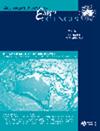塔斯马尼亚西北部Kennaook/Cape Grim中新世海底火山演替的修订地层学和第一次地质年代学
IF 0.9
4区 地球科学
Q3 GEOSCIENCES, MULTIDISCIPLINARY
引用次数: 0
摘要
澳大利亚塔斯马尼亚岛西北部的Kennaook/Cape Grim是中新世海底板内玄武岩火山活动的遗址。该序列保存特别完好,以枕状熔岩、块状熔岩和枕状破碎角砾岩为主。火山产物的总量(1.1 km3)在全球范围内相对较小,但保存是世界级的。最古老的单元Woolnorth凝灰岩不整合位于新元古代岩角群上。火山岩的第一次40Ar/39Ar测年显示整个层序的年龄为早中新世(24.5-23 Ma)。羊毛北凝灰岩几乎完全由反硝化的玄武岩玻璃碎片和橄榄石晶体碎片组成。Woolnorth凝灰岩被位于Kennaook/Cape Grim的Slaughter Bluff火山角砾岩(23.12±0.19 Ma)覆盖。斯劳特崖火山角砾岩以弥散层状枕状破碎角砾岩为主。Kennaook/Cape Grim北部,小三叶草玄武岩(约24 Ma)侵入Woolnorth凝灰岩。在Kennaook/Cape Grim以南,Woolnorth凝灰岩被Studland Bay玄武岩(23.73±0.08 Ma)覆盖,并被新发现的Hippo玄武岩(24.52±0.12 Ma)侵入。Studland Bay玄武岩包括玄武岩枕状熔岩丘,随后是一系列弥散层状、基质为主、枕状碎片角砾岩和玄武岩角砾岩。详细的野外测绘和采样显示,所有Kennaook/Cape Grim单元的沉积环境都是海底环境,它们的就位时间相对较快。Kennaook/Cape Grim火山演替的第40Ar/39Ar地质年代学。小三叶草玄武岩已从陆上挤压单元重新解释为海底侵入单元。一个新的侵入单元,河马玄武岩,已被确认。对Kennaook/Cape Grim火山演替地层进行了修正。本文章由计算机程序翻译,如有差异,请以英文原文为准。
Revised stratigraphy and first geochronology of the Miocene submarine volcanic succession at Kennaook/Cape Grim, northwestern Tasmania
Abstract Kennaook/Cape Grim in far northwestern Tasmania, Australia, was a site of submarine intraplate basaltic volcanism during the Miocene. The succession is exceptionally well preserved and is dominated by pillow lava, massive lava and pillow fragment breccia. The total volume of volcanic products (1.1 km3) is relatively small on a global scale, but the preservation is world class. The oldest unit, the Woolnorth Tuff lies unconformably on the Neoproterozoic Rocky Cape Group. The first 40Ar/39Ar dating of the volcanic rocks reveals an early Miocene (24.5–23 Ma) age for the entire sequence. The Woolnorth Tuff is composed almost entirely of devitrified basaltic glass shards and olivine crystal fragments. The Woolnorth Tuff is overlain by the Slaughter Bluff Volcanic Breccia (23.12 ± 0.19 Ma) at Kennaook/Cape Grim. The Slaughter Bluff Volcanic Breccia is dominated by diffusely bedded pillow fragment breccia. North of Kennaook/Cape Grim, the Little Trefoil Basalt (ca 24 Ma) intrudes the Woolnorth Tuff. To the south of Kennaook/Cape Grim, the Woolnorth Tuff is overlain by the Studland Bay Basalts (23.73 ± 0.08 Ma) and intruded by a newly recognised unit, the Hippo Basalt (24.52 ± 0.12 Ma). The Studland Bay Basalts comprise mounds of basaltic pillow lavas followed by a succession of diffusely bedded, matrix-dominated, pillow fragment breccia and basaltic breccia. Detailed field mapping and sampling have revealed that the environment of deposition of all Kennaook/Cape Grim units was submarine and that they were emplaced in relatively rapid succession. KEY POINTS First 40Ar/39Ar geochronology for the Kennaook/Cape Grim volcanic succession. Little Trefoil Basalt has been re-interpreted from a subaerial extrusive unit to a submarine intrusive unit. A new intrusive unit, the Hippo Basalt, has been recognised. The stratigraphy of the Kennaook/Cape Grim volcanic succession has been revised.
求助全文
通过发布文献求助,成功后即可免费获取论文全文。
去求助
来源期刊

Australian Journal of Earth Sciences
地学-地球科学综合
CiteScore
2.80
自引率
8.30%
发文量
45
审稿时长
6-12 weeks
期刊介绍:
Australian Journal of Earth Sciences publishes peer-reviewed research papers as well as significant review articles of general interest to geoscientists. The Journal covers the whole field of earth science including basin studies, regional geophysical studies and metallogeny. There is usually a thematic issue each year featuring a selection of papers on a particular area of earth science. Shorter papers are encouraged and are given priority in publication. Critical discussion of recently published papers is also encouraged.
 求助内容:
求助内容: 应助结果提醒方式:
应助结果提醒方式:


